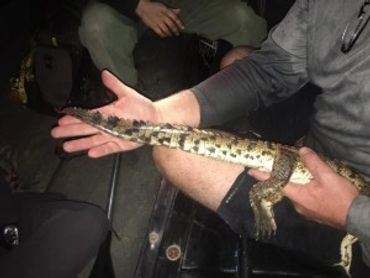Population Survey: Morelet's Crocodile in Chiquibul Forest
Project Description
Chiquibul Forest covers an area of 176,999 ha, and is comprised of three protected areas: Chiquibul National Park (106,838 ha); Chiquibul Forest Reserve (59,822 ha); and Caracol Archeological Reserve (10,339 ha). Because of its rich biodiversity, Chiquibul Forest is recognized at the national and international levels as a key biodiversity conservation area, comprising of 17 different natural ecosystems within Chiquibul Forest, and is considered the 2nd largest rainforest in the Americas, after the Amazon Rainforest.
The population of C. moreletii in Chiquibul Forest presents an interesting topic for investigation given the lack of human encroachment and encounters in this region, as well as in the amount of undeveloped habitat; such variables are rare in modern crocodylian studies. In collaboration with Friends for Conservation and Development (FCD), the CRC led a population study initiated in 2016 with the following objectives:
- Create baseline information of the demographics of C. moreletii
- Examine health via parasitism and heavy metal bioaccumulation
- Perform preliminary study of behavior and ecology
- Analyze genetics of this population in relation to other populations in Belize and throughout its range
- Equip and train the Friends for Conservation and Development (FCD) rangers on performing crocodile population surveys in order to establish annual or bi-annual research excursions.
In June 2016 & 2017, CRC along with colleague Shawn Heflick and FCD initiated a crocodile population survey to monitor and begin a conservation and management program for the Morelet’s crocodile of Chiquibul Forest. Based on the data from the 2016-2017 research project, the population of Morelet’s Crocodiles in Chiquibul Forest appears to be stable in a relatively healthy environment. This research initiated a program in which CRC plans to conduct surveys of this population every 5 years in order to provide significant data for the local conservation and management of this unique population, especially since it likely represents one of the few remaining genetically pure populations of C. moreletii in Belize. Hybridization between C. moreletii and C. acutus is common in areas of sympatry, and the discovery of C. acutus haplotypes further inland in typical C. moreletii habitat in Belize illustrates the loss of genetic integrity due to introgression. The continued isolation of C. moreletii in Chiquibul Forest provides a protective barrier for the genetic integrity of this population, as well as from anthropogenic influences (i.e., pollution, habitat loss, harassment, indiscriminate killing).
CRC has used the research opportunity presented by the massive biodiversity of the Chiquibul by studying more than crocodilians. In 2022, CRC began conducting baseline primate surveys in conjunction with the crocodile surveys. This research has been focused on collecting baseline population data of both spider and howler monkeys in the area surrounding Las Cuevas Research Station.
Research Update
In 2022, the CRC revisited the Chiquibul National Park to monitor the Morelet’s crocodile population of the Macal and Raspaculo Rivers in collaboration with FCD. During the nights of May 22 and 23, we conducted nocturnal eyeshine surveys and encountered a total of 142 individuals along a 47.75 km of survey route (encounter rate = 2.97 crocodiles/km). Of the 142 crocodiles observed, we classified 39 as hatchlings (27.5%), 39 as juveniles (27.5%), 19 as subadults (13%), 24 as adults (17%), and 21 as eyeshine only (15%). The relatively high percentage of hatchlings and juveniles in this population is likely the result of abundant nesting females, as the sex ratio for this habitat has proven to be strongly female-biased over decades of research.
In December 2022, we revisited Chiquibul National Park to lead two nights of capture surveys, in which we captured seven crocodiles on the Raspaculo River on December 13, 2022, and twelve crocodiles on the Macal River on December 14, 2022. Altogether, we captured and assessed 19 Morelet's crocodiles. Of the 19 crocodiles caught, we classified one as hatchling (5%), seven as juveniles (37%), four as subadults (21%) and six as adults (37%). All individuals appeared in excellent physical condition with little to no wounds. The overall population sex ratio was not significantly different from 1:1 as we captured ten males and nine females, However, Raspaculo River exhibited a strong female bias (1:2.5), which has only been observed in this area over the years. In both surveys, we did not encounter evidence of pollution. Nonetheless, FCD researchers suggest the Chalillo dam has caused a high concentration of mercury (Hg) in the river system. Although the crocodile population in the Chiquibul Forest seems stable and relatively free from threats, research and monitoring are warranted, especially since it represents one of the few remaining genetically pure populations of Morelet’s crocodile in Belize.
Project Update
Current genetic analysis from our 2023 field excursions are illustrating that the population of Morelet’s crocodiles are one the last pure genetic populations of Morelet’s crocodiles in-country given the majority of crocodiles are hybrids (hybiridzing with the American crocodile). This new finding illustrates the unique population of crocodiles in Chiquibul Forest, furthering the need of protection of the reserve.










This website uses cookies.
We use cookies to analyze website traffic and optimize your website experience. By accepting our use of cookies, your data will be aggregated with all other user data.